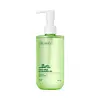What's inside
What's inside
 Key Ingredients
Key Ingredients

 Benefits
Benefits

 Concerns
Concerns

 Ingredients Side-by-side
Ingredients Side-by-side

Ethylhexyl Palmitate
EmollientSorbeth-30 Tetraoleate
EmulsifyingCaprylic/Capric Triglyceride
MaskingPolyisobutene
Parfum
MaskingCrambe Abyssinica Seed Oil
Skin ConditioningLimnanthes Alba Seed Oil
Skin ConditioningCaprylyl Glycol
EmollientEthylhexylglycerin
Skin ConditioningWater
Skin ConditioningMorus Alba Leaf Extract
Skin ConditioningMorus Alba Flower Extract
Butyl Avocadate
Skin ConditioningButylene Glycol
HumectantCentella Asiatica Extract
CleansingActinidia Chinensis Fruit Extract
EmollientLac Powder
Skin ConditioningSolanum Melongena Fruit Extract
Skin ConditioningCurcuma Longa Root Extract
MaskingOcimum Sanctum Leaf Extract
Skin ConditioningCoral Extract
Skin ConditioningCarum Carvi Seed Oil
Masking1,2-Hexanediol
Skin ConditioningSodium Hyaluronate
HumectantTocopherol
AntioxidantDaucus Carota Sativa Leaf Extract
Skin ConditioningPopulus Tremula Flower Extract
Skin ConditioningPropolis Extract
Skin ConditioningAsiaticoside
AntioxidantAsiatic Acid
Skin ConditioningMadecassoside
AntioxidantMadecassic Acid
Skin ConditioningEthylhexyl Palmitate, Sorbeth-30 Tetraoleate, Caprylic/Capric Triglyceride, Polyisobutene, Parfum, Crambe Abyssinica Seed Oil, Limnanthes Alba Seed Oil, Caprylyl Glycol, Ethylhexylglycerin, Water, Morus Alba Leaf Extract, Morus Alba Flower Extract, Butyl Avocadate, Butylene Glycol, Centella Asiatica Extract, Actinidia Chinensis Fruit Extract, Lac Powder, Solanum Melongena Fruit Extract, Curcuma Longa Root Extract, Ocimum Sanctum Leaf Extract, Coral Extract, Carum Carvi Seed Oil, 1,2-Hexanediol, Sodium Hyaluronate, Tocopherol, Daucus Carota Sativa Leaf Extract, Populus Tremula Flower Extract, Propolis Extract, Asiaticoside, Asiatic Acid, Madecassoside, Madecassic Acid
Water
Skin ConditioningGlycerin
HumectantDipropylene Glycol
HumectantSodium Cocoamphoacetate
CleansingPotassium Cocoyl Glycinate
Lauryl Glucoside
CleansingPolyglyceryl-6 Caprylate
EmulsifyingCoco-Glucoside
Cleansing1,2-Hexanediol
Skin ConditioningLauryl Hydroxysultaine
CleansingAcrylates Copolymer
Sodium Chloride
MaskingDisodium Cocoamphodiacetate
CleansingMaltodextrin
AbsorbentPPG-7
Skin ConditioningLactobacillus Ferment Lysate
Skin ConditioningParfum
MaskingButylene Glycol
HumectantDisodium Cocoyl Glutamate
CleansingArgania Spinosa Kernel Oil
EmollientSaponins
CleansingEthylhexylglycerin
Skin ConditioningArginine
MaskingAspartic Acid
MaskingGlutamic Acid
HumectantTetrasodium EDTA
Acrylates/Stearyl Methacrylate Copolymer
Emulsion StabilisingCollybia Mushroom Extract
Hyaluronic Acid
HumectantXanthan Gum
EmulsifyingDisodium EDTA
Ceramide NP
Skin ConditioningTocopherol
AntioxidantWater, Glycerin, Dipropylene Glycol, Sodium Cocoamphoacetate, Potassium Cocoyl Glycinate, Lauryl Glucoside, Polyglyceryl-6 Caprylate, Coco-Glucoside, 1,2-Hexanediol, Lauryl Hydroxysultaine, Acrylates Copolymer, Sodium Chloride, Disodium Cocoamphodiacetate, Maltodextrin, PPG-7, Lactobacillus Ferment Lysate, Parfum, Butylene Glycol, Disodium Cocoyl Glutamate, Argania Spinosa Kernel Oil, Saponins, Ethylhexylglycerin, Arginine, Aspartic Acid, Glutamic Acid, Tetrasodium EDTA, Acrylates/Stearyl Methacrylate Copolymer, Collybia Mushroom Extract, Hyaluronic Acid, Xanthan Gum, Disodium EDTA, Ceramide NP, Tocopherol
 Reviews
Reviews

Ingredients Explained
These ingredients are found in both products.
Ingredients higher up in an ingredient list are typically present in a larger amount.
1,2-Hexanediol is a synthetic liquid and another multi-functional powerhouse.
It is a:
- Humectant, drawing moisture into the skin
- Emollient, helping to soften skin
- Solvent, dispersing and stabilizing formulas
- Preservative booster, enhancing the antimicrobial activity of other preservatives
Butylene Glycol (or BG) is used within cosmetic products for a few different reasons:
Overall, Butylene Glycol is a safe and well-rounded ingredient that works well with other ingredients.
Though this ingredient works well with most skin types, some people with sensitive skin may experience a reaction such as allergic rashes, closed comedones, or itchiness.
Learn more about Butylene GlycolEthylhexylglycerin (we can't pronounce this either) is commonly used as a preservative and skin softener. It is derived from glyceryl.
You might see Ethylhexylglycerin often paired with other preservatives such as phenoxyethanol. Ethylhexylglycerin has been found to increase the effectiveness of these other preservatives.
Parfum is a catch-all term for an ingredient or more that is used to give a scent to products.
Also called "fragrance", this ingredient can be a blend of hundreds of chemicals or plant oils. This means every product with "fragrance" or "parfum" in the ingredients list is a different mixture.
For instance, Habanolide is a proprietary trade name for a specific aroma chemical. When used as a fragrance ingredient in cosmetics, most aroma chemicals fall under the broad labeling category of “FRAGRANCE” or “PARFUM” according to EU and US regulations.
The term 'parfum' or 'fragrance' is not regulated in many countries. In many cases, it is up to the brand to define this term.
For instance, many brands choose to label themselves as "fragrance-free" because they are not using synthetic fragrances. However, their products may still contain ingredients such as essential oils that are considered a fragrance by INCI standards.
One example is Calendula flower extract. Calendula is an essential oil that still imparts a scent or 'fragrance'.
Depending on the blend, the ingredients in the mixture can cause allergies and sensitivities on the skin. Some ingredients that are known EU allergens include linalool and citronellol.
Parfum can also be used to mask or cover an unpleasant scent.
The bottom line is: not all fragrances/parfum/ingredients are created equally. If you are worried about fragrances, we recommend taking a closer look at an ingredient. And of course, we always recommend speaking with a professional.
Learn more about ParfumTocopherol (also known as Vitamin E) is a common antioxidant used to help protect the skin from free-radicals and strengthen the skin barrier. It's also fat soluble - this means our skin is great at absorbing it.
Vitamin E also helps keep your natural skin lipids healthy. Your lipid skin barrier naturally consists of lipids, ceramides, and fatty acids. Vitamin E offers extra protection for your skin’s lipid barrier, keeping your skin healthy and nourished.
Another benefit is a bit of UV protection. Vitamin E helps reduce the damage caused by UVB rays. (It should not replace your sunscreen). Combining it with Vitamin C can decrease sunburned cells and hyperpigmentation after UV exposure.
You might have noticed Vitamin E + C often paired together. This is because it is great at stabilizing Vitamin C. Using the two together helps increase the effectiveness of both ingredients.
There are often claims that Vitamin E can reduce/prevent scarring, but these claims haven't been confirmed by scientific research.
Learn more about TocopherolWater. It's the most common cosmetic ingredient of all. You'll usually see it at the top of ingredient lists, meaning that it makes up the largest part of the product.
So why is it so popular? Water most often acts as a solvent - this means that it helps dissolve other ingredients into the formulation.
You'll also recognize water as that liquid we all need to stay alive. If you see this, drink a glass of water. Stay hydrated!
Learn more about Water